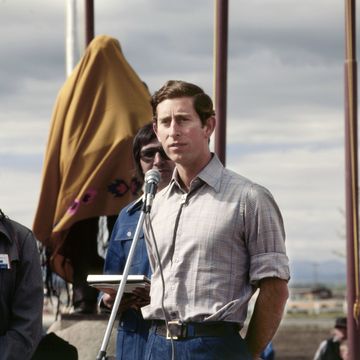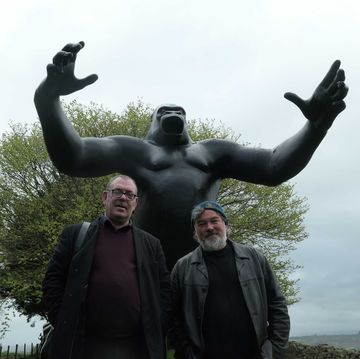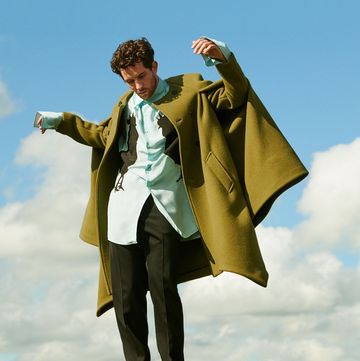1. ‘You couldn’t make it up’
At 1pm on Thursday, 18 June 2015, two men climbed over a padlocked gate just behind The Daneway Inn. The pub stands in the Cotswolds, an insufferably quaint range of rolling hills and postcard villages in central England. It is three, connected, white-washed cottages built in the late 18th century for workers building the canal that runs through its garden. Beyond that is a steep grassland meadow that now operates as a nature reserve called Daneway Banks. Theirs was a curious way to gain admission to the enclosure, mainly because there was an open entrance less than 100m up the hill. They were clocked immediately by a butterfly enthusiast, Neil Hulme, who works for the British charity Butterfly Conservation but who was visiting the site on holiday.
The more active of the pair, Phillip Cullen, was short and stocky. He walked stiffly, like he’d left the coat hanger in his clothes. He wore a checked shirt and a blue cap with a Nike swoosh; in one hand was a white plastic bag and in the other was a green net with short green pole. For the next four hours, Hulme followed the men around the site, taking notes and surreptitiously photographing their actions.
“I’ve got absolutely nothing against Cullen as a human being,” Hulme says, “but I object strongly to what he was doing. And on that basis I was prepared to ruin my holiday and spend the day rolling around like a commando collecting evidence to make sure we could bring a case that would stick.”
While his accomplice disappeared under the shade of a beech tree, Cullen began to take swipes — seemingly unsuccessful — with his net. At this time, Hulme called the police, but mobile reception is erratic in this part of the country and the call couldn’t be placed. Occasionally, Cullen would pass something to his companion, whom Hulme believed was acting as “a lookout”. After a couple of hours of skulking round remote corners of the reserve, Cullen ditched the net and reappeared holding a small video recorder. He now engaged in what Hulme “perceived to be the exaggerated use” of the camera and began animated discussion with other visitors to the site in an effort, perhaps, to come across as a legitimate hobbyist. When another member of Butterfly Conservation asked Cullen whether he was using a net, he denied owning one.
The reason everyone was on Daneway Banks that afternoon was the “large blue”, Maculinea arion, one of Britain’s rarest and most coveted butterflies. The species is globally endangered and it was actually declared extinct in the country in 1979, but a dedicated and unprecedented conservation effort has seen it reintroduced to 33 sites. The locations of many of these populations are closely guarded secrets, but Daneway Banks, which supports the second largest number of large blues in England (and therefore effectively the world), is well-known among lepidopterists. When the site was officially opened in 2016, the Prince of Wales did the honours.
The following day, 57-year-old Cullen and his accomplice appeared, helpfully wearing the same clothes, on another nature reserve dedicated to the large blue. Here, at Collard Hill in Somerset, a volunteer warden — pre-warned by a report from Hulme, circulated overnight — was waiting for them. When she questioned Cullen, he claimed he was only interested in parasitic wasps. These sightings provided strong circumstantial evidence, but Cullen was ultimately brought down by his eBay records. These listings, which showed illegal specimens bought and sold, some from as far afield as Java in Indonesia, were sufficient for magistrates to issue a warrant to search his home.
At 9am, on 13 February 2016, police arrived at Cullen’s address, on the outskirts of Bristol, with two butterfly experts from the Natural History Museum. Cullen, who is unemployed, lives in social housing with his wife and a grown-up son. The search of the two-bedroom house did not take long. There was a pile of rocks in the living room, which were part of another collection, and then — bingo. There in a cabinet was drawer after drawer of rare butterflies, arranged and pinned under glass, including more than 20 examples of large blues. The most recent of these were captioned “DB18” and “CH18”. Cullen insisted that the labels referred to “Dark Blue” and “Cobalt Hue”. In court, the prosecutors speculated that they were references to Daneway Banks and Collard Hill, and that 18 tallied with 18 June, the day he was seen in the Cotswolds.
The magistrates agreed and, in March 2017, Cullen was convicted for capturing, killing and possessing large blue butterflies. It was the first time an individual had been prosecuted in Britain for harming an insect, and a prison sentence was considered. In the event, Cullen was spared jail time, but he had to pay a £380 fine and perform 250 hours of community service.
Perhaps it was a slow news day or maybe it was respite from the relentless cycle of terrorism and political squabbles, but something about the Cullen trial caught the imagination. Most of the British newspapers covered the story, but so too did The New York Times, The Times of India and Arab News, a daily newspaper in Saudi Arabia. For most of these foreign outlets, it was clearly a tale of British eccentricity. Invariably, too, the reports mentioned in either the headline or the opening sentence that Cullen used to be a bodybuilder. The image of a muscle-bound hulk chasing a frail butterfly around with a child’s shrimping net was certainly a gift.
But, around the margins, among serious lepidopterists, another discussion was taking place. Butterfly collecting was widely thought to be a relic of a less civilised time: a hobby made obsolete in the Sixties by the rise of the conservation movement and improvements in cameras. These people began to ask: was Cullen a lone weirdo? Or was he part of a renegade underground movement that took butterflies either for their own personal hauls or to sell online for around £400 a specimen?
Some of the answers could be found not long after on specialist insect-collecting forums, a place for like-minded individuals to discuss their finds and gossip about the going rate for prize specimens: there were almost audible gasps recently when a female Morpho cypris chrysonicus, a brilliant blue and white butterfly from South America, went for over £1,250, plus shipping. Here the prevailing opinion was that Cullen was an idiot, but less for targeting the large blue than for managing to get caught doing it. On these chatrooms, under the anonymity of usernames, modern collectors describe feeling just as hunted now as the dainty prey that they still stalk.
“The man was stupid yes, but he caught two butterflies, yes two,” wrote dp1965 on The Insect Collectors’ Forum. “And in the grand scheme of things, with all that’s going on in the world right now, it hardly makes him Herr Hitler. But the loony treehuggers want him crucified. Not only that, they also want you and I crucified, too. And I have tasted their bitter venom and been made to feel like a serial killer, for this, the most gentle hobby on planet earth with some of the most gentle people I have ever met. You couldn’t make it up.”
2. ‘Everyone’s frightened of sharks, everyone loves butterflies’
There is considerable skill in mounting and displaying a butterfly. It takes many attempts before you have anything even semi-presentable. First, and most important, you need to kill the specimen without harming its delicate wings. Vladimir Nabokov, the novelist and one-time official curator of lepidoptera at Harvard’s Museum of Comparative Zoology, favoured squeezing the creature’s thorax to explode its heart. But this method needs considerable dexterity, an unflinching constitution and long, sharp nails, so a chemical alternative is often sought. In the early days, this might mean ether or cyanide, although cotton balls soaked in ethyl acetate, which is less noxious and smells not-unpleasantly of boiled sweets, is preferred now. Death takes place in what’s called a killing jar.
Some essential kit is required. You need entomologist’s forceps — sharp-pointed tweezers, really — to unfurl the wings without ripping them. Then insect pins and a spreading board on which to dry out the butterfly. After a few weeks it will be brittle and ready to display in a cork-lined wooden box, ideally made from mahogany. Historically, these would have been fumigated with naphthalene, the main ingredient of mothballs, another dangerous carcinogen, but now freezing the specimens for three days is the preferred method to repel the notorious anthrenus museorum, or museum beetle. You will also attach a label in neat cursive detailing where and when you found the butterfly. Then they are meticulously filed away. No serious collector would display a case on the wall, as the specimens would mottle and deteriorate very quickly. They need to be kept in darkness, and taken out only occasionally to be admired.
What inspires a human being to kill a butterfly? For non-collectors, it might be hard to fathom, but the impulse must be similar to the one that exists behind most hobbies. It is a pursuit to swallow up spare hours and it allows you to spend satisfying sums on specialist equipment. Collecting gets you out of the house, often to bucolic spots, and you are left with an exotic keepsake to remind you of summer as the nights draw in.
Still, butterfly collecting does seem a strange way to spend your days; an activity so arcane it wouldn’t totally surprise you if it was reclaimed by hipsters in Hackney. The golden age of lepidoptery — as the scientific study of butterflies and moths is known — was around the turn of the last century in Britain. Rich men (and it was almost exclusively a male pastime) would travel around the UK and the empire hunting for trophies. Their attire, typically, was tweed suits; one accessory du jour was a top hat lined with cork, so that the insects could be pinned immediately. These chaps would leap around fields swiping at the air with a fine-meshed net or they would engage local children to do the work for them for a modest fee.
Over the past 300 years, huge numbers of the great and the good have been collectors. While bombs fell during WWII, Winston Churchill planned a sumptuous butterfly garden at Chartwell, his country house in Kent. Britain’s wartime leader started at the age of six, and his drawers were filled with exotic specimens picked up on military campaigns in Sudan, Pakistan and South Africa. His dream enclosure was to feature fountains of water and honey, and he even wanted to reintroduce a large butterfly called the Black-veined White, Aporia crataegi, which had become extinct in Britain in 1925. It was never realised in his lifetime, but today 20-odd varieties of native butterflies can be found in Chartwell’s gardens.
Nabokov is the great chronicler of butterflies: both directly in poems and autobiography, and more obliquely in his fiction, including Lolita. He actually discovered some new species and named one Nabokov’s Blue, although it was latterly demoted to a subspecies. More recently, butterflies have been a leitmotif of the British artist Damien Hirst’s work. When asked in 1997 why they recurred so often in his art, he explained: “You have to find universal triggers: everyone’s frightened of glass, everyone’s frightened of sharks, everyone loves butterflies.”
Where there are butterflies, death is never far away. Hirst’s work “In and Out of Love” (1991) was an installation in which tropical butterflies erupted out of chrysalises, pinned to boards, leaving behind a pink and gold fluid that some thought to be butterfly “blood”. In a 2012 retrospective, the work took over two rooms of the Tate Modern. Animal-rights campaigners were furious when it was revealed that more than 9,000 Heliconius and Owl butterflies, which usually have a lifespan of nine months in the wild, died during the 23 weeks that the exhibition was open. Another Hirst piece, “I am Become Death, Shatterer of Worlds” (2006) — a riff on the Bhagavad Gita scripture quote made famous by J Robert Oppenheimer, father of the atomic bomb — was made entirely from a kaleidoscopic arrangement of thousands of butterfly wings, covering more than five metres across and two metres high. It sold at Christie’s London auction house for £2.1m in 2010.
Butterfly collecting, as nature writer Patrick Barkham once noted, is invariably “a male, if not especially masculine, preserve”. In the early days, Aurelian (literally “the golden one”) societies were only open to men, much like gentlemen’s clubs; killing anything back then was deemed unladylike. As the subject became a formal science this, too, tended to exclude women, who were less likely to receive a university education. One suspects that it is not a coincidence that the virtual death of butterfly collecting in recent times has overlapped neatly with the increasing involvement of women in lepidoptery.
Of course, the rarest and most exotic butterflies have long aroused the most deranged passions. The large blue, which cannot be bred in captivity, was always a special trophy. In 1896, a new colony was discovered in Cornwall. Within weeks, collectors descended in hordes and swiped an estimated 2,660 large blues. An aristocrat called John Augustus Bouck, a baron of the Russian Empire, was especially enamoured with the species: when his butterfly collection was auctioned in 1939, it featured more than 900 large blues, the most extensive “series” ever assembled.
But there’s something misleading about these tales of excess. Poaching is almost never the reason that a butterfly species becomes extinct. Invariably it’s destruction of habitat that finishes them off. One of the starkest examples of this is the Xerces Blue, Glaucopsyche xerces, North America’s large blue, which exists now only as three trays of pinned specimens in the California Academy of Sciences at Golden Gate Park in San Francisco. It, too, was known for its beauty; Nabokov called it “celestially innocent”. It thrived on the coastal sand dunes of the Sunset District until urban development cleared the natural dunes and the silver lupines that its caterpillars required. The Xerces Blue was last seen alive in 1943.
It was a similar story with the large blue in Britain. Ultimately what decided its fate was not the zeal of Victorian gentlemen, but the fact that the thin-soiled grasslands where they lived were abandoned by farmers because they were agriculturally unproductive. In this context, the idea that a man could be sent to prison for taking two, admittedly endangered, butterflies seems something of an extreme punishment.
3. Britain’s giant panda
The large blue, contrary to reasonable assumption, is actually quite a small butterfly. Each wing is no bigger than a postage stamp. It is definitely blue though, splendidly so. At its finest, it is the inky indigo of Japanese selvedge denim, which dissolves into a black border and is then framed by a stark outer edge of white. Even in the pulchritudinous world of butterfly chasing — which must be like judging a beauty pageant in Sweden — it is regarded as something of a looker. And it’s the biggest of the diminutive Blue family, hence the name.
On an Arcadian summer’s day back in June, under skies the same colour as its wings, I went in search of the large blue on Green Down in Somerset. Finding one is, in no sense, a walk in the park. It is often called the most neurotic of butterflies: its life cycle is macabre and frankly a bit kinky. As an adult, it appears “on the wing”, in entomologist-speak, in very specific places, at very particular times and only in perfect conditions for very brief periods. The large blue doesn’t like it too hot or too cold, and if there’s a gust of wind, forget about it.
The large blue favours south-facing sites covered in wild thyme and the best chance to see it is to catch it sunbathing. Green Down is a nature reserve in the middle of nowhere — the closest town of note is Glastonbury, and it so happens that the large blue often appears at the same time as the famous music festival — but that hasn’t deterred a few dozen butterfly obsessives from combing this remote meadow in the hope of a sighting. Accompanying me are Jeremy Thomas, Professor of Ecology at Oxford University, and David Simcox, his right-hand man. These are the two men responsible for reintroducing the large blue to Britain and no one in the world knows more about these fragile creatures. You might imagine that the study of butterflies would attract colourful oddballs, but this pair are clearly very sensible, almost disappointingly so. Thomas is dogged and deeply rational, Simcox more emotional, and these qualities have proved exactly what was required to bring the large blue effectively back from the dead.
“The large blue has been elevated, in the insect world, to the equivalent of giant pandas,” explains Thomas, a spry septuagenarian, as we puff up a steep hill beside a railway track that carries trains between London and Taunton. Marbled Whites, Meadow Browns, Ringlets and Thomas’s first Gatekeeper of the season all flit and wobble by, but he scarcely turns his head. The large blue is known for its lazy, faltering flight; some say it looks drunk.
“It always had this charisma originally among the old butterfly collectors,” Thomas continues. “It was one of the great prizes, because it was very, very rare and most people think it’s very beautiful. I don’t like the word ‘iconic’ but it’s used a lot. Before cars existed, people made their way to site by horse and trap and they’d camp on site for three weeks. And they would spend every day of their holidays trying to collect large blues. Lots of people did, not just one or two.”
It is not illegal to collect and kill butterflies in the UK. But there are rules that need to be followed. There is a list of species that receive full legal protection and there are places (such as nature reserves and national parks) where you would require a permit. Britain is home to 59 species of butterflies, six are absolutely off-limits under the 1981 Wildlife and Countryside Act, and the most high-profile of these is the large blue.
While the Phillip Cullen case was a first in the UK, there have been previous convictions in the US. Most prominent was the 1993 indictment of Richard Skalski, Thomas Kral and Marc Grinnell for poaching and trafficking in butterflies protected by the Endangered Species Act. Between them, the men possessed 11 of the 16 restricted North American butterflies, and Skalski and Kral, especially, were operating at near-Victorian prolificacy. Kral, who was just 31 at the time of the trial in 1995, had one species, now known as the St Francis Satyr, so rare that it was not even known to exist; he’d collected 50 of them. The 1,637 illegal butterflies seized from Kral’s home in Tucson, Arizona, were actually only two per cent of his total collection. The three men also avoided jail, but like Cullen had to pay fines and do community service.
Cullen was small-time compared to Skalski, Kral and Grinnell’s sophisticated ring, and it became clear very quickly that the British authorities were not dealing with a master criminal. Simcox, the large blue project officer, tells me, almost sympathetically, “He [Cullen] was not an educated man, which consistently made it difficult for him, really.” Ian Guildford, an investigative support officer for the National Wildlife Crime Unit, who was involved in Cullen’s arrest, is even more damning: “Our friend, he’s not the brightest button in the box, that’s for sure.”
Echoing comments made on insect-collecting forums, Neil Hulme, the man who spotted Cullen and tracked him on Daneway Banks, was especially incredulous of his decision to carry out his activities on one of the most popular sites for large blue at a peak time of day for visitors. Either he was very confident that he would not be challenged, or he’s a first-order numbskull. “It seems crazy to me to carry a net, because if you were what I’d call a clever collector, you would take butterflies when they were at roost in a discreet manner without the need for a net,” says Hulme. “I know that if I wanted to, I could take some small pots in my pocket out in the evening when most people had gone home and find large blues asleep and surreptitiously just pot them.”
Perhaps it was the bodybuilder tag, but Cullen could certainly come across as intimidating. When the police arrived at his house with a search warrant, he was aggressive and unhelpful, and there was a discussion over whether he should be arrested for perverting the course of justice. He has a long police record including theft, actual bodily harm, possession of drugs and criminal damage. These are mostly historical, dating from his teens and twenties, but he had some public order offences — essentially arguments with neighbours — from the past decade. There was an odd moment in court when Cullen’s accomplice, called as a witness for the defence, denied being his “friend”. They had known each other for 20 years, the man clarified to the magistrates, but that was because their wives both came from Thailand. He joined Cullen on the excursions because he was interested in the architecture of railway bridges.
After he was found guilty, Cullen went up to the witnesses who had testified against him and said, “See you on the sites this year.” This comment was enough to earn him a criminal behaviour order banning him for five years from the three main large blue reserves.
“We come across two types of people,” says Guildford. “My impression of Cullen is that he was just an obsessive collector. They’re not in it for the money, it’s just the obsession of collecting the rarest thing you can find. Or building your collection. And then you’ve got the real criminals who are in it for the financial gain.”
Guildford catches himself, “I say ‘real criminals’; he’s a criminal, too.”
4. Sod’s law
On Green Down, the June sun continues to beat down and our search for a large blue remains unresolved. This gives Jeremy Thomas the opportunity to trace his own relationship with the butterfly, which now goes back five decades. In 1972, he was a PhD student in his mid-twenties not long out of Cambridge University. The large blue was on the precipice of extinction in the UK and Thomas was tasked with finding out why. For the next six summers, with pretty much only cricket commentary from Test Match Special on the radio for company, he lived with the last remaining colony in a remote spot on the edge of Dartmoor National Park.
“It did mess up your social life a bit,” he concedes, “but because it was a lovely part of the world, quite a number of my friends would come and take holidays. So we’d stay up drinking, putting the world to rights, and they’d lie in bed until 10 or 11 in the morning after that, and I’d be up at seven and on the site.”
What Thomas realised — belatedly it turned out — was that the large blue has some very specific requirements in order to breed. It is a predator, the only one in Britain (the rest feed on plants). Its prey is one species of red ant called Myrmica sabuleti, which, as a tiny caterpillar, it tricks into thinking that it is their queen by singing softly to it and emulating its smell. The ants then dutifully carry it back to their brood chamber, where it spends 10 months resting on a silk pad and bingeing on ant grubs until it is ready to pupate. The whole life cycle is sometimes compared to the movie Alien.
Sadly, by the time Thomas had joined all the dots, the last colony of large blues in Britain was no more. To reintroduce the species, he and Simcox had to take eggs from a very similar butterfly in Sweden. Just as he is explaining this, Thomas spots a flash of blue and races off in pursuit. It’s not. It is. It’s a large blue! “Oh, it’s a really, really tatty one,” he harrumphs. “It’s a male, probably 10 days old. Argh, that really is sod’s law.”
A butterfly’s wings, their colours and patterns, are made up of tiny, overlapping scales. These are at their brightest for the first day or two, but over time, the scales fall out or rub off. No discerning collector would be interested in a faded specimen like this one, but there is still something pulse-quickening about seeing it. The large blue might be pernickety and ornery, but that is what has given this tiny insect its power over humans for centuries. As David Simcox says that day to a middle-aged couple who had driven more than 150 miles on a futile search for a large blue: “If it was easy, it wouldn’t be any fun at all.”
This sighting also makes some sense as to why some people were so angry about Phillip Cullen. For the trial, Thomas was asked to present a statement on the impact that butterfly collectors could have on the large blue population. His conclusion was that, on the two sites where Cullen was spotted with his net, the effect would be meaningless. “I don’t trumpet this very loudly,” he says, “but to Daneway or Collard, the numbers that someone can actually physically collect are trivial.”
More important for Thomas was the psychological toll that the poaching had and the message it sends out. The large blue now flies in Britain in greater numbers than at any time since the Thirties. It is a heart-warming conservation story in an age that desperately needs one. “So there has been great satisfaction at the success of the project and a universal feeling of dismay when there is evidence someone is collecting and killing these hard-won butterflies,” says Thomas, after our large blue has flown skittishly away. “It’s almost akin in certain people to the sense of violation sometimes felt by house owners after a robbery.”
5. Hangar 51
A month earlier, in May 2017, I had met Ian Guildford at the Natural History Museum. He was in London to escort the two cases of butterflies seized at Phillip Cullen’s house to add to the museum’s collection. It is already, by some margin, the most extensive library in the world: at last count there are 8,712,000 dead butterflies and moths sitting in 80,000 glass-fronted drawers in high, polished mahogany cabinets. If they were laid out rather than stacked, they would cover around 30 football pitches. The collection can be viewed by application only, for security reasons.
Cullen’s is a tiny addition to the collection: Walter and Charles Rothschild, two English bankers and amateur entomologists who lived at the turn of the 20th century, contributed a quarter of it — more than 2,000,000 butterflies and moths — when they died. Walter used to boast that there wasn’t a single duplicate in his entire collection. Guildford drove Cullen’s two boxes into a rear entry to the museum and they were promptly put in a freezer for 72 hours to kill any bugs that could infest them or attack the museum’s collection.
Is there a long-term plan for them? “I’ll have to ask the curator,” he replies. “He might make an exhibition of seized goods. There’s massive vaults, millions of butterflies. They get a lot of collections surrendered: ‘Grandad’s just died, I don’t want them…’ But this one, I don’t know.”
In just one generation, butterfly collecting has gone from being an acceptable pastime for prime ministers to being viewed with deep suspicion. Esquire approached Cullen for this article and he had no interest in discussing the case; neither did a handful of other collectors contacted through forums or even commercial dealers of butterflies. The activity has become a faint embarrassment: the boxes of butterflies are now, in the words of Professor Beth Tobin from the University of Georgia, “suspended somewhere between memorabilia and rubbish”.
In 1963, John Fowles published his first novel, The Collector. He wrote more famous works — notably The Magus and The French Lieutenant’s Woman — but his debut was especially personal. It told the story of a sadistic butterfly obsessive called Frederick Clegg who kidnaps an art student, Miranda Grey, sedating her with chloroform. For Fowles, a repentant collector himself, there was a clear metaphor: the unforgiveable compulsion of some individuals to take a thing of beauty, deprive it of freedom and finally kill it. The Collector would subsequently prove popular with serial killers: Leonard Lake, who along with Charles Chi-Tat Ng, is believed to have killed 25 people in California in the Eighties, loved the novel; Christopher Wilder, aka The Beauty Queen Killer, was found with a copy of the book when he was gunned down by police in New Hampshire in 1984 at the end of his six-week, cross-country killing spree.
The link between collecting and psychopathy is well trodden both in fiction and reality. In The Silence of the Lambs, serial killer Buffalo Bill stuffs moths into his victims’ throats as a calling card. Again, the insects are a metaphor for dispatching living things silently, dispassionately. The film poster featured a death’s-head hawkmoth, which has a distinctive white skull on its back. Among 400 pieces of correspondence confiscated in the 1995 case of the three Americans found guilty of flouting the Endangered Species Act, there were repeated references to their status as outsiders. Kral, a man responsible for the death of around 80,000 butterflies, signed off one letter to Skalski, “Yours in mass murder, Tom.”
It’s worth reminding ourselves — lest we become carried away by stories of genuine monsters — that we are not necessarily talking about an illegal activity. Back on the collectors’ forums, there is the strong feeling, discussing the Cullen case, of a stitch-up. Anyone, they huff, can happily slaughter spiders, wasps, even moths, but touch a butterfly and you become an outcast. In this reading, writes dp1965 on The Insect Collectors’ Forum again, the reintroduction of the large blue was “an ego trip for a handful of self-righteous, self-styled, self-proclaimed conservation gurus”. He goes on to claim that charitable groups such as Butterfly Conservation “post lies galore in order to further their cause which is to put a stop to this ‘barbaric and Victorian pastime’ that we call a hobby and brainwash their followers like lobotomised sheep who don’t have one original thought of their own.”
The peculiar thing is that almost all of the entomologists and butterfly fanciers that I did meet started out as collectors. One said that when he first became interested, far back in the early Sixties, it was impossible to imagine how anyone could study butterflies and moths and not also pin and preserve them. Sir David Attenborough, an official national treasure and the world’s most beloved naturalist, once said his most profound embarrassment was that he used to be a collector. He had huge numbers of South American blue morphos and Queen Alexandra’s birdwings, the largest butterfly in the world, that he captured in Papua New Guinea.
On Green Down, everyone seems content to track the large blues with their cameras these days, but it’s a similar story. “When I was a kid, I collected butterflies,” says David Simcox, who is in his sixties. “Everyone did. I can remember in 1980 being at a big international symposium with Jeremy called the ‘Biology of Butterflies’ at the Natural History Museum. There was a lot of talk then about the impact of collecting and right at the end of this quite fierce debate, somebody stood up and said, ‘Could everyone who started their interest in butterflies as collectors, as children, stand up?’ And about 95 per cent of the audience stood up.
“But that was then,” he continues. “And times have moved on. There’s no excuse to do it now. Whatsoever.”
In the closing scene of Raiders of the Lost Ark, the Ark of the Covenant, so painstakingly earned, is packed in a crate and deposited in the bowels of Hangar 51, a storage facility for the US military. The city of boxes is a clear nod both to Area 51 in Nevada and Hangar 18 in Ohio, where conspiracy theorists believe that UFO remains and US military secrets are hidden away from view. Leaving the Natural History Museum, after Guildford had dropped off the Cullen specimens, it’s hard not to think of the collection, now swollen to 8,712,100 slightly shameful, slowly disintegrating bodies lined up in their mahogany trays, stacked up in cabinets, waiting for the moment they will see daylight again, which may never come.














